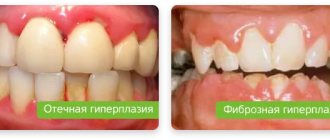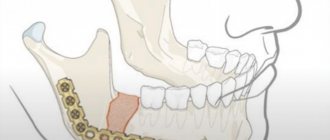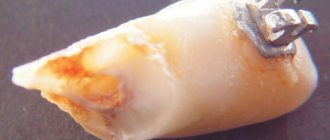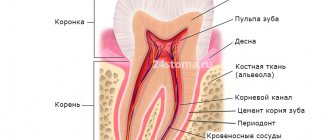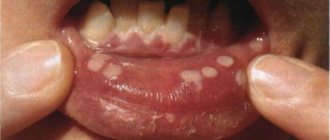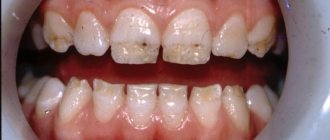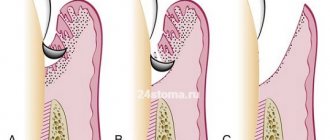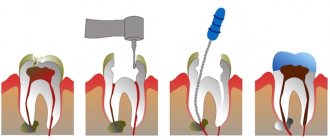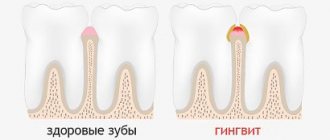All tissues of the oral cavity, both teeth and gums, are interconnected and naturally have a complex structure. Gums, just like teeth, require careful and thorough care. Periodontology is a separate science in dentistry that deals with the study of gum disease. Inflammation from the teeth can spread to periodontal tissue, and vice versa. Therefore, it is so important to maintain careful hygiene of the entire oral cavity and promptly treat any dental diseases.
What it is
Periodontium is periodontal tissue, the main function of which is to hold the tooth in the alveolus. All periodontal tissues are interconnected, so any changes in the functioning of one or another element inevitably affect the functioning of other elements. The periodontal structure includes periodontium, gums, alveolar processes and cementum. Some dental scientists also include tooth enamel, dentin and pulp in its composition.
The term “periodontium” appeared in dentistry a little over a hundred years ago and has since firmly taken its place in modern dentistry, although in Russia the term “took root” a little later, around the mid-30s of the last century. of periodontology deals with a thorough study of the periodontium, its main functions, structure, and possible diseases .
DENTINE
Dentin in its structure resembles coarse-fibrous bone tissue, consisting of a basic substance penetrated by a large number of dentinal tubules. The main substance of dentin consists of collagen fibers, between which there is an amorphous adhesive substance. The outer layer of dentin (with a radial arrangement of fibers) is called mantle; the inner layer with a tangential arrangement of fibers is peripulpar. Dentinal tubules (tubules) have the shape of round, oval tubes. They begin in the tooth cavity, bending in a wave-like manner, pass through the thickness of the dentin and end in flask-shaped swellings in the area of the dentino-enamel junction.
In the lumen of these tubules there are dentinal processes of odontoblasts. Dentin contains 70-72% inorganic substances (mainly phosphate and calcium carbonate), and 28-30% is water and organic matter (proteins, fats and carbohydrates).
Tooth enamel Tooth enamel is the hardest tissue of the human body. In the area of the cusps of the tooth crown there is the thickest layer of enamel; towards the cervical area the thickness of the enamel decreases. Enamel prisms are the main structural formation of enamel. The enamel prism is a faceted cylindrical fiber that begins at the dentinoenamel junction.
It bends in an S-shape, runs radially and ends on the surface of the tooth crown. Enamel prisms are connected into bundles (10-20 each), directed radially from the dentinoenamel junction to the outer surface. The thickness of the prisms is from 3 to 6 microns. Each prism contains thin cytoplasmic fibers that form an organic mesh, in the loops of which crystals of mineral salts are located.
Enamel prisms and interprismatic spaces (in electron microscopic examination) consist of strictly oriented hydroxyapatite crystals arranged in a certain order, the length of which ranges from 50 to 100 nm.
Most of the tooth enamel consists of inorganic matter (95%), organic (1.2%) and water (3.8%). Tooth enamel contains 96.5% mineral salts, of which about 54% are phosphorus and calcium (17% and 37%, respectively), which are represented by hydroxyapatite crystals.
Structure and functions
The periodontal structure includes:
- Desna . Soft tissues that cover part of the tooth root, protecting it from the external environment. The gums are based on collagen fibers, which take an active part in the functionality of the dentofacial apparatus. The soft tissue of the gums is covered on top with epithelium, which has excellent regenerative properties.
- Alveolar process of the jaw . Bone bed of the tooth. It consists of two bone plates, has a spongy structure and is filled with vessels and nerves.
- Periodont . A special connective tissue that fills the space between the alveolar process and the tooth. Consists of special connective fibers, blood and lymphatic vessels, and nerve fibers.
- Cement . Refers to the tissues of the tooth and covers the root of the tooth. Its structure resembles bone tissue.
- Tooth enamel . The hardest part of the tooth, it covers the surface of the crown of the tooth. It is thanks to the hardness of tooth enamel that we can bite and chew food.
- Dentin . Refers to the tissues of the tooth, it is covered with cement and enamel. Dentin is less hard than tooth enamel, it has a huge number of tubules, as well as a cavity filled with pulp.
- Dental pulp . The softest dental tissue, which is responsible for the innervation and nutrition of the tooth. The pulp consists of connective tissue, nerves and blood vessels.
Functions of periodontium:
- Support-retaining . Fixation of the tooth in the alveolus. Thanks to the ligamentous apparatus of the periodontium, alveolar process and gums, the tooth is securely fixed inside the alveolus in a suspended state and does not fall out of its place even under fairly heavy loads.
- Shock-absorbing . Evenly distributes pressure on the teeth and jaw while chewing food. This is facilitated by the presence of connective tissue and tissue fluid, which acts as a natural shock absorber.
- Trophic . It is provided due to the presence of blood and lymphatic vessels, as well as a large number of different nerve receptors.
- Barrier or protective . It is carried out due to the protective properties of the gum epithelium, the presence of lymphoid, plasma and mast cells, the presence of enzymes and other active substances.
- Reflex . It is carried out using the oral mucosa and the presence of nerve receptors in periodontal tissues. Responsible for the force of chewing pressure during eating.
- Plastic . High ability of periodontal tissues to regenerate due to the presence of fibroblasts and osteoblasts.
Periodontal functions
In a healthy state, the periodontium performs a number of functions assigned to it:
- Support. The main function is due to which the tooth is held between bone plates.
- Shock-absorbing function. Correctly distributes pressure over the entire dentition.
- Trophic. A function responsible for nutrition and ensuring metabolism of the tissue complex.
- A protective function that helps create a barrier against the effects of bacteria.
- Reflex – affects the correct distribution of the chewing load.
- The plastic function is responsible for the elasticity of periodontal tissues.
Etiology and pathogenesis of periodontal diseases
The pathogenesis of periodontal diseases has not been fully established. It is known that at different stages of the development of periodontology, the causes of periodontal diseases such as
- general diseases of the body;
- presence of dental plaque;
- the presence of a large number of aggressive harmful bacteria in the patient’s mouth.
The etiology of periodontal diseases lies in the presence of dental plaque, without which the occurrence of diseases is simply impossible. It is the presence of dental plaque that is the primary factor in the occurrence of periodontal diseases.
Secondary factors include:
- presence of tartar;
- traumatic occlusion;
- the presence of low-quality fillings or dentures in the patient’s mouth;
- anomalies in the position of teeth and bite;
- structural features of soft tissues;
- features of saliva composition;
- genetic predisposition;
- frequent stress;
- hormonal imbalance;
- smoking.
Local factors:
Local factors include, first of all, dental plaque, which is a consequence of improper and untimely oral hygiene. It is a conglomerate of food debris and the bacteria that live in them.
Figure 3. Plaque under a microscope
At first, the plaque is soft and can be easily removed with a toothbrush, but over time, bacteria firmly bind to the tooth enamel and the plaque gradually turns into tartar (1), which constantly injures the gums (2) and is a constant source of infection of the tissues surrounding it ( 3-6).
Figure 4. Local causes of periodontal disease development
In addition to dental plaque, local factors also include overload of periodontal tissues, insufficient chewing of food, and underload of certain groups of teeth.
Differential diagnosis of diseases
The doctor makes a diagnosis based on the results of examining the patient's oral cavity using dental instruments, as well as on the results of an x-ray examination. It is also important to ask the patient in detail about the symptoms, their intensity, and nature. It is very important to conduct a detailed clinical examination of the patient to exclude the presence of other diseases.
Differential diagnosis of periodontal diseases is based on the analysis of radiographic data. With gingivitis, there are no changes in the bone base of the periodontium.
When diagnosing periodontal diseases, so-called indices are often used, which make it possible to determine the degree of the inflammatory process and changes in bone tissue, which allows for the most accurate diagnosis.
Possible signs
Based on the nature of the flow, the following options are distinguished:
Acute catarrhal pericoronitis
During the process of teething, the patient experiences unpleasant sensations, which intensify when eating. The mucous membrane in the affected area will be red, swollen and painful when touched. Regional lymph nodes increase in size. Their palpation becomes painful.
Acute purulent pericoronitis
With this form of the disease, pain increases. Purulent discharge appears from under the hood. Pain when eating is accompanied by discomfort when swallowing. Mouth opening is limited.
The patient's general condition changes. There is an increase in body temperature to 37.5-38 degrees. Sleep is also disturbed and appetite is lost.
Chronic pericoronitis
The chronic course of the disease occurs if the necessary treatment is not carried out in a timely manner. Painful sensations decrease in intensity and appear only periodically. Since the hood remains, food continues to get trapped under it. This leads to bad breath. Regional lymph nodes are slightly enlarged and painful only on palpation. Swallowing and mouth opening are not impaired.
Vector device in periodontology
The Vector device allows you to quickly and reliably cure patients of many symptoms. It not only helps to get rid of the disease, but also activates the reserve forces of the periodontium, which allows you to avoid many problems in the future. With the invention of the Vector device, periodontics has reached a qualitatively new level of disease treatment. Literally in one visit to the doctor you can get rid of such unpleasant symptoms as bleeding gums, inflammation and soreness of the gums. Moreover, the treatment is almost painless.
The Vector periodontal device was invented in Germany and is most often used to remove dental plaque, which is the main cause of periodontal disease. Using the device, you can also treat the surface of the teeth with ultrasound before fixing the dentures. However, its main purpose is the treatment of periodontal diseases.
If you have suffered greatly from an inflammatory disease, Vector will help replace curettage, which is why the device is often used for osteoplasty and gingivoplasty.
Treatment of periodontal diseases
The general treatment program for periodontal diseases includes:
- removal of microbial plaque and mineralized deposits from the surface of teeth;
- caries therapy;
- preventing functional overload of certain areas of the dentition;
- rejection of bad habits;
- carrying out orthodontic treatment (if indicated);
- anti-inflammatory therapy;
- combating systemic diseases;
- the use of drugs that enhance immunity, stimulate osteogenesis and activate the adaptive and protective functions of the body;
- carrying out general hygiene measures (monitoring the regime of work, nutrition, rest, hygiene).
The treatment regimen for periodontal diseases is drawn up taking into account all manifestations of the disease and the results of a comprehensive examination of the patient. Timely seeking of professional help by a patient significantly improves the prognosis of the disease, shortens the duration of treatment and avoids the development of complications.
